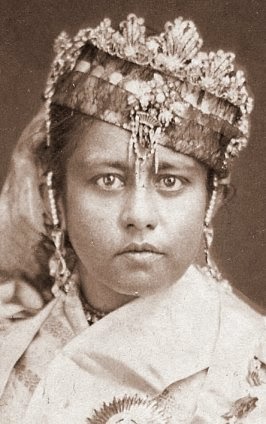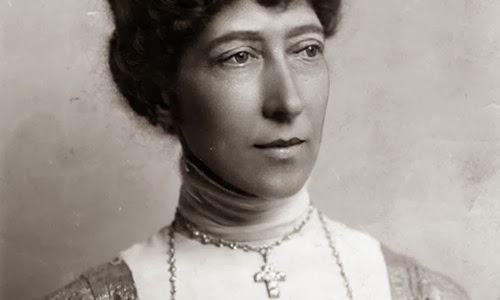
This Week in Royal Jewels: February 14-20

Sparkling Royal Jewels From Around the World

 |
| Badge of the Imperial Order of the Crown of India [1] |
 |
| Queen Victoria, ca. 1882 [2] |
 |
| Nawab Shahjihan Begum of Bhopal, ca. 1872 [4] |
Eight royal Indian women were also among the original membership of the order. Maharani Bamba, something of a real-life Cinderella, was the wife of the last Maharaja of Lahore. Nawab Shahjihan Begum was the ruler of Bhopal in her own right; her elderly grandmother, Nawab Kudsia Begum, was also made a companion. Maharani Vani Vilasa Sannidhana Kempananja Ammani Avaru was the wife of one Maharaja of Mysore and the mother (and regent) of another. Maharini Jamnabai Sahib Gaekwad, the widow of the Maharaja of Baroda, was also the adopted mother of a subsequent Baroda ruler. Sahebzadi Dialwar unisa Begum Saheba was the grandmother of the Nizam of Hyderabad. Vijaya Mohenu Mukta Boyi was the daughter of the last Raja of Tanjore, and some recognized her as her father’s successor. Maharani Swarnamoyee of Cossimbazar was renowned for her charity work.
Seventeen additional women, all related to the past and present colonial officials in India, were also recognized as original companions of the order. The Dowager Countess of Elgin, Lady Mayo, Lady Susan Bourke, Lady Jane Baring, Lady Lytton, Lady Lawrence, and Lady Strachey were all wives, widows, or daughters of Viceroys and Governors-General of India. Lady Mary Temple-Nugent-Brydges-Chandos-Grenville, Lady Hobart, Lady Napier, and Lady Denison were all wives or daughters of Governors of Madras. Lady Frere and Lady Temple were wives of Governors of Bombay. Viscountess Halifax’s husband was in charge of the British East India Company. Lady Salisbury, Lady Ripon, and Lady Northcote were wives of Secretaries of State and (Under-Secretaries of State) of India.
Over the next seventy years, many more British princesses, Indian royals, and relatives of colonial officials were added to the order’s ranks. In 1947, when British colonial control of India ended, the order was essentially suspended; as you can imagine, there’s been no need to add new companions to an imperial order of chivalry based in a country that has since gained its independence.
Today, there is exactly one living person who was invested as a member of the order during its tenure: Queen Elizabeth II, who was made a companion on June 12, 1947. Her sister, Princess Margaret, was made a companion of the order on the same day, even though she was only sixteen. (You can see Margaret wearing the insignia of the order in this portrait; it is placed on her left shoulder, above her family orders.) Both of the princesses were appointed to the order during the celebrations of the official birthday of their father, King George VI [5]. India gained independence from Britain two months later, on August 15, 1947.
 |
| Princess Louise, Princess Royal and Duchess of Fife [1] |
Ursula’s run-down of Louise’s wedding gifts, which is based on contemporary news reports, describes the piece as “a splendid cross, composed of large rose-cut brilliants, which measures in an inch and a half in length” [2]. The cross was not a present from one of her relatives or a specific member of the British aristocracy; instead, it was a gift from “the gentlemen of Norfolk” [3].
The generosity of the people of Norfolk toward Louise is surely connected with the royal family’s estate in Norfolk, Sandringham House. The estate was the home of Edward VII and Alexandra, who were still the Prince and Princess of Wales when Louise married in 1889. Queen Victoria had purchased the estate for the Waleses at the time of their marriage in the early 1860s, and Louise and her siblings spent much of their childhood there. It’s still an important retreat for the Windsors, and it’s one of the only properties that belongs to the family in their own right rather than to the Crown.
 |
| Maud, Louise, and Alexandra ca. 1911, the year of the wreck of the Delhi [4] |
Even sadder, though, were the effects of the wreck on the health of Louise’s husband. The Duke of Fife developed pleurisy shortly afterward and died in Egypt. Princess Alexandra, who inherited much of her mother’s jewelry, became Duchess of Fife in her own right following her father’s death. Who knows — perhaps the Norfolk cross was among the pieces she received from Louise? We may never know. Small jewels like this, especially those that don’t hold a great deal of sentimental value, are extremely easy to auction off quietly. The cross may be hiding away in the Fife family’s collection, or it may have parted ways with them long ago.
NOTES, PHOTO CREDITS, AND LINKS
1. Cropped version of photographic portrait available here.
2. See Ursula’s website for much more information on Louise’s gifts.
3. See the article syndicated in the West Coast Times.
4. Cropped version of photograph available via Wikimedia Commons; source here.
5. See this article from the Auckland Star.